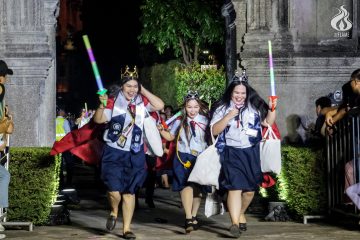
YOU MIGHT have dwelt on the stories of the duwende, tikbalang, white lady, or kapre at one point in time during your childhood.
But the belief in these creatures is more than just eerie tales. They are ingrained in the Filipino culture and have been inspiring artists to create terrifying yet appealing works.
Filipino myths, legends, epics, and the like often serve as inspiration in various forms of art of painters, writers, filmmakers, and animators, according to the National Commission for Culture and Arts (NCCA).
These tales may have been used to scare children but they remain relevant to Filipinos as they form part of their culture.
“Superstitions are part of the daily lives of the Filipinos […] it is deeply rooted in our culture and it has been with us almost since the beginning of time,” Melanie Turingan, a history professor at the UST Faculty of Arts and Letters, told The Flame.
Turingan said young people still recognize superstitions as old beliefs. And even though they may brush it off as arbitrary, these beliefs are possibly entrenched in their upbringing.
“I think the youth still believes in superstitions and the like, although many new generations are not affected by the beliefs, and consider them only a part of the old ways,” Turingan said.
“Our belief still depends on the matter of the application of our family, peers, or even from our experiences […] Even before the colonizers came, Filipinos had several beliefs and practices that are innate in the place where they came from,” she added.
Curiosity

While they may not necessarily believe in supernatural creatures, some young people are fascinated by them or at least by the way they were depicted by their elders.
Clary Sunga, a 21-year-old creative writing student who lives in Laoag, Ilocos Norte, is fascinated by the idea of mermaids, as most parts of the sea are yet to be discovered.
“Even if mermaids are real or not, the mere idea of something existing down there is fascinating. No one has ever really explored the very deepest part of the seas […] a what-if question is always worth exploring, even in one’s imagination,” Sunga told The Flame.
Riene Dimakiling, a 21-year-old communication student who lives in Samar, said some people in his province have linked the cases of missing persons to engkantos or enchanted beings.
“It is intriguing to hear that the engkantos may be the reason for [the] cases of missing people. Some crimes [in our place] remain unsolved, and people here tend to believe [it is because of] mythical reasons,” Dimakiling told The Flame.
Although Filipino superstitions and tales about otherworldly creatures are known to entertain Pinoys, they can also captivate readers from Europe and North America, according to Mellie Lopez’s Handbook of Philippine Folklore.
Among the prominent foreigners who are fans of Philippine mythology is British comic creator Neil Gaiman, who has encouraged Filipinos to support local artists who dwell on the subject.
While superstitions are seen by some as backward and ancient beliefs – they have been there even before the arrival of Spanish colonizers, according to historians – they still help Filipinos make decisions.
“Others may think that it is just mere coincidence, so they will [think] that they will be more careful […] Sometimes, these beliefs are considered bizarre but still serve as warnings, additional information, or still remain popular even if it is outdated,” Turingan said.
“Superstitions still exist and continue to shape the opinions, decisions, values, and actions of Filipinos in modern times,” Turingan added.
Lingering presence
Even at a time when people seek logical explanations for everything, it is difficult to shake off myths that were used to allay fears of the unknown. But their lingering presence in the Filipino consciousness may not necessarily be a bad thing as they form part of the nation’s culture and identity, experts said.
“We deal with superstitions whether we are fully aware of them or not. Even with the onset of modern science and technology, it is still difficult to do away with these beliefs,” Turingan said.
In a journal article titled ‘Creation Myths among the Early Filipinos’ that was published in 1968, Jesuit priest Francisco Demetrio said Filipinos would realize that their ancient myths and tales are created with their ‘own character and culture,’ and these age-old folklores should be treasured.
“[They] will awaken to the fact that [their] ancient traditions are not something to be ashamed of, but something to be cherished and valued because they mirror forth the history of the human spirit as it rises up to higher conquests through the forces of ignorance, meanness, and irrationality,” he wrote.
According to the NCCA, superstitions, myths, legends, and the like are part of the ideas and attitudes of people as a national community, and Filipinos are motivated to be responsible for preserving their cultural heritage.
Popular culture also plays a role in retaining these beliefs in the Filipinos collective memory. For instance, the animated series adaptation of the graphic novel ‘Trese,’ which features creatures like the aswang, santelmo, and nuno, became the most-watched show in video streaming service Netflix for weeks. Documentaries and features about unexplained occurrences also attract a lot of views in video-sharing sites like Youtube.
Sunga believes the tales that have kept children awake at night deserve to be retold and passed on to succeeding generations.
“We come from diverse communities, so I’m sure there are a lot of stories still left untold. [I think] it is necessary to keep these stories alive,” Sunga said. F – Theriz Lizel R. Silvano with Samantha Z. Argonza



